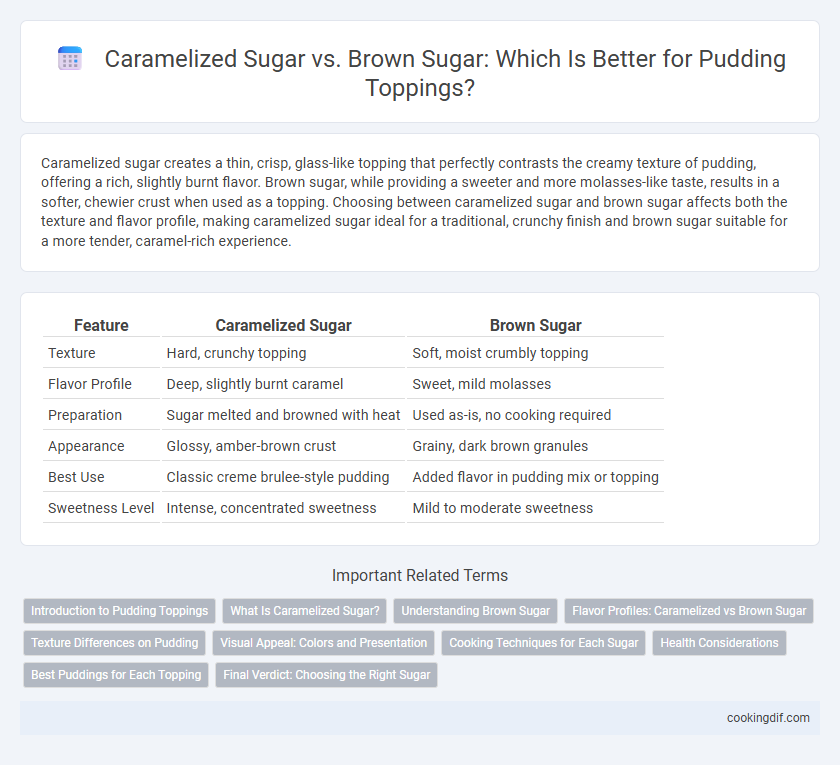Caramelized sugar creates a thin, crisp, glass-like topping that perfectly contrasts the creamy texture of pudding, offering a rich, slightly burnt flavor. Brown sugar, while providing a sweeter and more molasses-like taste, results in a softer, chewier crust when used as a topping. Choosing between caramelized sugar and brown sugar affects both the texture and flavor profile, making caramelized sugar ideal for a traditional, crunchy finish and brown sugar suitable for a more tender, caramel-rich experience.
Table of Comparison
| Feature | Caramelized Sugar | Brown Sugar |
|---|---|---|
| Texture | Hard, crunchy topping | Soft, moist crumbly topping |
| Flavor Profile | Deep, slightly burnt caramel | Sweet, mild molasses |
| Preparation | Sugar melted and browned with heat | Used as-is, no cooking required |
| Appearance | Glossy, amber-brown crust | Grainy, dark brown granules |
| Best Use | Classic creme brulee-style pudding | Added flavor in pudding mix or topping |
| Sweetness Level | Intense, concentrated sweetness | Mild to moderate sweetness |
Introduction to Pudding Toppings
Caramelized sugar creates a crisp, crunchy topping with a rich, deep flavor that contrasts beautifully with the creamy texture of pudding. Brown sugar, with its moist texture and molasses content, lends a softer, slightly chewy topping and a sweeter, more nuanced taste. Choosing between caramelized sugar and brown sugar affects both the texture and sweetness level, enhancing the pudding experience based on personal preference.
What Is Caramelized Sugar?
Caramelized sugar is created by heating white granulated sugar until it melts and turns into a rich, amber-colored syrup with a deep, complex flavor ideal for pudding toppings. Unlike brown sugar, which contains molasses and adds moisture and a mild sweetness, caramelized sugar offers a crisp texture and a slightly bitter, toasted flavor that enhances the dessert's contrast. This process intensifies sugar's natural sweetness and adds a sophisticated caramel aroma, making it a popular choice for achieving a glossy, crunchy layer on puddings such as creme brulee.
Understanding Brown Sugar
Brown sugar contains molasses, giving it a moist texture and rich flavor that enhances pudding toppings with a deep, caramel-like sweetness. Unlike caramelized sugar, which hardens into a brittle crust, brown sugar creates a softer, chewier layer that blends smoothly with creamy pudding. Its higher moisture content prevents burning, making it ideal for achieving a balanced, subtly sweet topping.
Flavor Profiles: Caramelized vs Brown Sugar
Caramelized sugar topping on pudding delivers a deep, rich flavor with hints of toffee and a slight bitterness that enhances the dessert's complexity. Brown sugar topping provides a milder, sweeter taste with subtle molasses notes, offering a smoother and more comforting flavor profile. Choosing caramelized sugar adds a bold, intense caramel essence, while brown sugar imparts warmth and sweetness without overpowering the pudding's natural flavors.
Texture Differences on Pudding
Caramelized sugar creates a thin, crisp crust that adds a satisfying crunch and a slightly burnt, complex flavor to pudding. Brown sugar melts into a softer, more moist topping that enhances the pudding's sweetness with a rich, molasses-like taste. Texture differences impact the overall mouthfeel, with caramelized sugar providing a contrast to smooth pudding, while brown sugar results in a tender, chewy layer.
Visual Appeal: Colors and Presentation
Caramelized sugar creates a rich, amber-colored crust with a glossy finish that enhances the visual appeal of pudding through its shiny, glass-like surface and deep golden hues. Brown sugar produces a darker, matte topping with subtle reddish undertones, offering a rustic and textured appearance that contrasts softly against creamy pudding. The choice between caramelized sugar and brown sugar significantly impacts the presentation, with caramelization providing a more vibrant and elegant color, while brown sugar adds warmth and a homey feel.
Cooking Techniques for Each Sugar
Caramelized sugar creates a glassy, brittle topping by melting sugar until it reaches the hard crack stage, requiring careful temperature control to avoid burning. Brown sugar caramelizes more quickly due to its molasses content, producing a softer, chewier crust with deeper flavor notes. Using a kitchen torch or broiler enhances the caramelization process for both sugars, offering textural contrasts suited to different pudding varieties.
Health Considerations
Caramelized sugar contains fewer impurities and may have a slightly lower glycemic index than brown sugar, which retains molasses and minerals but has a higher sugar content. Brown sugar offers trace amounts of calcium, potassium, and iron but can contribute more to blood sugar spikes due to its higher sucrose levels. Choosing caramelized sugar for pudding toppings can reduce added moisture and potentially lower the glycemic impact, which is beneficial for those managing blood sugar levels.
Best Puddings for Each Topping
Caramelized sugar creates a crisp, glassy topping ideal for classic creme brulee and rich flan puddings, offering a deep, bittersweet flavor perfect for contrasting creamy textures. Brown sugar's molasses content provides a moist, caramel-like crust that enhances bread pudding and sticky toffee pudding with a warm, robust sweetness. Selecting caramelized sugar suits delicate custards, while brown sugar complements dense, spiced puddings for optimal flavor balance.
Final Verdict: Choosing the Right Sugar
Caramelized sugar creates a rich, glossy topping with a crisp texture that enhances the pudding's flavor complexity, making it ideal for creme brulee or similar desserts. Brown sugar adds a deep molasses note and moist, slightly chewy consistency, perfect for puddings requiring a softer, caramel-like finish. Selecting the right sugar depends on the desired texture and flavor intensity, with caramelized sugar offering crisp elegance and brown sugar providing warm, robust sweetness.
Caramelized sugar vs Brown sugar for topping Infographic

 cookingdif.com
cookingdif.com